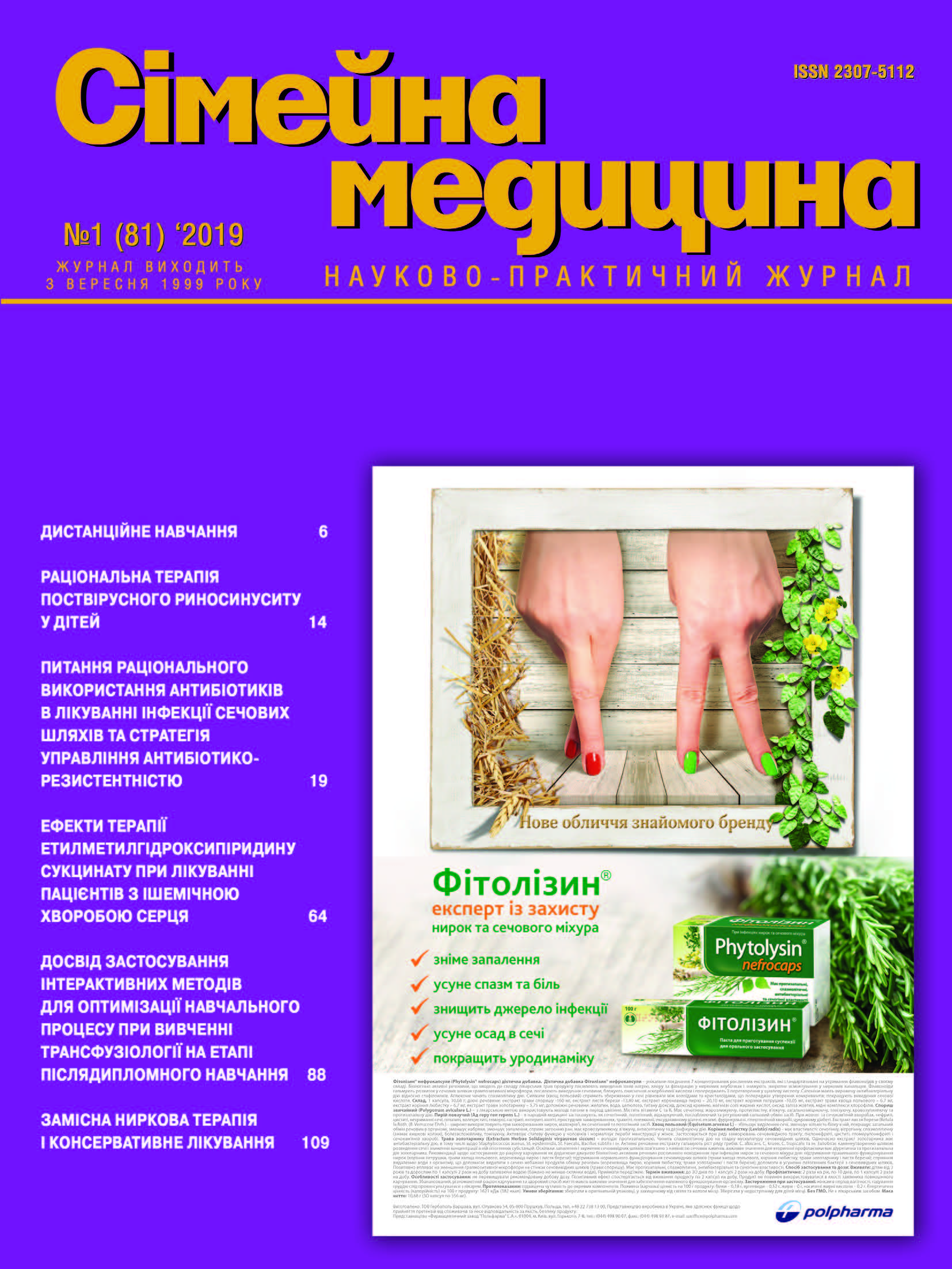The Prevention of Cardiovascular Diseases in Diabetes Mellitus: Role of Glycemic Control
##plugins.themes.bootstrap3.article.main##
Abstract
The article discusses the relationship of glycemia control with the development of mid-vascular pathology. Proved a clear link glycemic control with a reduced risk of micro- and macrovascular complications of diabetes. At present, the ideology of early intervention is actively developing and is gaining more and more admirers. Effective competent self-monitoring of blood glucose is one of the fundamental factors in slowing down and preventing the development of cardiovascular complications of diabetes. The maintenance of a high quality of life of the patient is no less important than the achievement of target values of glycemia.
##plugins.themes.bootstrap3.article.details##

This work is licensed under a Creative Commons Attribution 4.0 International License.
Authors retain the copyright and grant the journal the first publication of original scientific articles under the Creative Commons Attribution 4.0 International License, which allows others to distribute work with acknowledgment of authorship and first publication in this journal.
References
Kengne AP, Patel A, Marre M et al. Contemporary model for cardiovascular risk prediction in people with type 2 diabetes. Eur J of Cardiovasc Prevent Rehab 2011; 18: 393–8. https://doi.org/10.1177/1741826710394270
Ogurtsova K, da Rocha Fernandes JD, Huang Y et al. IDF Diabetes Atlas: Global estimates for the prevalence of diabetes for 2015 and 2040. Diabetes Res Clin Pract 2017; 128: 40–50. https://doi.org/10.1016/j.diabres.2017.03.024
Yudkin JS, Richter B, Gale EAM. Intensified glucose lowering in type 2 diabetes: time for a reappraisal. Diabetologia 2010; 53 (10): 2079–85. https://doi.org/10.1007/s00125-010-1864-z
Khaled AA, Sekaran M, Ikram SI. Type 2 diabetes and vascular complications: A pathophysiologic view. Biomed Res 2010; 21 (2): 147–50. Full text
Bartnik M, Ryden L, Ferrari R et al. The prevalence of abnormal glucose regulation in patients with coronary artery disease across Europe. The Euro Heart Survey on diabetes and the heart. Eur Heart J 2004; 25 (21): 1880–90. https://doi.org/10.1016/j.ehj.2004.07.027
Duckworth WC, McCarren M, Abraira С. Glucose Control and Cardiovascular Complications: The VA Diabetes Tria. Diabetes Care 2001; 24 (5): 942–5. https://doi.org/10.2337/diacare.24.5.942
Bouche JL, Hurrell DJ. Cardiovascular Disease and Diabetes. Diabet spectrum 2008; 21(3): 154–5. https://doi.org/10.2337/diaspect.21.3.154
Bai J, Ding X, Du X et al. Diabetes is associated with increased risk of venous thromboembolism: a systematic review and meta-analysis. Thrombosis Research 2015; 135(1): 90–5. https://doi.org/10.1016/j.thromres.2014.11.003
Dentali F, Ageno W, Pomero F. Time trends and case fatality rate of in-hospital treated pulmonary embolism during 11 years of observation in Northwestern Italy. Thromb Haemost 2016; 115 (2): 399–405. https://doi.org/10.1160/TH15-02-0172
Powers WJ, Derdeyn CP, Biller J et al. 2015 AHA/ASA Focused Update of the 2013 Guidelines for the Early Management of Patients With Acute Ischemic Stroke Regarding Endovascular Treatment: A Guideline for Healthcare Professionals From the AHA/ASA. Stroke 2015; 46 (10): 3020–35. https://doi.org/10.1161/STR.0000000000000074
Meschia JF, Bushnell C, Boden-Albala B et al. Guidelines for the primary prevention of stroke: a statement for healthcare professionals from the AHA/ASA. Stroke 2014; 45 (12): 3754–832. https://doi.org/10.1161/STR.0000000000000046
Johnston KC, Hall CE, Kissela et al. Glucose regulation in acute stroke patients (GRASP) trial a randomized pilot trial. Stroke 2009; 40 (12): 3804–09. https://doi.org/10.1161/STROKEAHA.109.561498
Capes SE, Hunt D, Malmberg K et al. Stress hyperglycaemia and increased risk of death after myocardial infarction in patients with and without diabetes: a systematic overview. Lancet 2000; 355 (4): 773–8. https://doi.org/10.1016/S0140-6736(99)08415-9
Capes SE, Hunt D, Malmberg K et al. Stress hyperglycemia and prognosis of stroke in nondiabetic and diabetic patients: a systematic overview. Stroke 2001; 32: 10: 2426–32. https://doi.org/10.1161/hs1001.096194
Holman RR, Paul SK, Bethel MA et al. 10-year follow-up of intensive glucose control in type 2 diabetes. N Engl J Med 2008, 359 (15): 1577–89. https://doi.org/10.1056/NEJMoa0806470
The CREATE-ECLA Trial Group Investigators. Effect of glucose-insulinpotassium infusion on mortality in patients with acute ST-segment elevation myocardial infarction the CREATE-ECLA Randomized Controlled Trial. JAMA 2005; 293 (4): 437–46. https://doi.org/10.1001/jama.293.4.437
NICE-SUGAR study investigators. Intensive versus conventional glucose control in critically ill patients. N Engl J Med 2009; 360 (13): 1283–97. http://doi.org/10.1056/NEJMoa0810625
Bruno A, Kent TA, Coull BM et al. Treatment of hyperglycemia in ischemic stroke (THIS): a randomized pilot trial. Stroke 2008; 39 (2): 384–9. https://doi.org/10.1161/STROKEAHA.107.493544
Wiener RS, Wiener DC, Larson RJ. Benefits and risks of tight glucose control in critically ill adults: a meta-analysis. JAMA 2008; 300: 933–44. https://doi.org/10.1001/jama.300.8.933
Gerstein HC, Miller ME, Byington RP et al. Action to Control Cardiovascular Risk in Diabetes Study Group. Effects of intensive glucose lowering in type 2 diabetes. N Engl J Med 2008; 358 (24): 2545–59. https://doi.org/10.1056/NEJMoa0802743
Patel A, MacMahon S, Chalmers J et al. ADVANCE Collaborative Group. Intensive blood glucose control and vascular outcomes in patients with type 2 diabetes. N Engl J Med 2008; 358 (24): 2560–72. https://doi.org/10.1056/NEJMoa0802987
Duckworth W, Abraira C, Moritz T et al. VADT Investigators. Glucose control and vascular complications in veterans with type 2 diabetes. N Engl J Med 2009; 360 (2): 129–39. https://doi.org/10.1056/NEJMoa0808431
Tian F, Chen Y, Liu H et al. Assessment of characteristics of neointimal hyperplasia after drug-eluting stent implantation in patients with diabetes mellitus: an optical coherence tomography analysis. Cardiology 2014; 128 (1): 34–40. https://doi.org/10.1159/000357612





